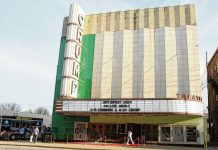A future vision for a core neighborhood in Columbus will be the focus when city planners present the final draft of the Columbus Central Neighborhood Plan.
Under development since early 2017, the City of Columbus — Bartholomew County Planning Department will present the plan during a two-hour open house starting 6 p.m. Monday at the Bartholomew Consolidated School Corp. administration building, 1200 Central Ave.
The plan is focused on the neighborhood surrounding the former Golden Casting Foundry, an area that has seen significant transitions as factories have been replaced with multi-family developments or transformed into restaurants or stores.
Planning Director Jeff Bergman and senior planner Emilie Pinkston said the neighborhood’s continuing transition from industrial to residential, while still retaining some industry and commercial locations, led the department to want to examine how the area is changing and what infrastructure could be needed as changes continued.
[sc:text-divider text-divider-title=”Story continues below gallery” ]Click here to purchase photos from this gallery
The plan calls for establishing new zoning districts within the Central neighborhood to designate areas where a mix of office, fabrication, assembly, maker spaces or light industrial uses would be compatible with a walkable urban setting.
A different zoning designation would be available for high-density apartment complexes such as Ashford Park and the Gateway Apartments, located on the former Golden Foundry site.
There would also be zoning for a multi-family district for a variety of multi-family housing types and densities, such as duplexes, fourplexes, courtyard apartments and townhomes, an element that could bring more affordable housing to the area, the planners said.
Other possible projects include:
Streetscape improvements along 16th Street, between Union Street and Grand Avenue, including new sidewalks, curb extensions and ramps and pedestrian crosswalks.
Greenspace enhancements in open space owned by Bartholomew Consolidated School Corp. at the southeast and northeast corners of Cottage Avenue and 13th Street, with seating and play spaces, along with planning of a new bus hub at the northeast corner of the intersection.
Streetscape improvements on 13th Street between Chestnut Street to the Haw Creek Trail, including new sidewalks, curb extensions and ramps and pedestrian crosswalks.
Designating truck routes in the neighborhood
Streetscape improvements to Michigan Avenue between 10th and 16th streets, including new sidewalks, curb extensions and ramps and pedestrian crosswalks.
Prioritize renter- and owner-occupied homes surrounding the industrial core, including seeking grant funding and prioritizing properties in the neighborhood for the city’s Pilot Homebuyer Purchase Program, through the Lincoln-Central Neighborhood Family Center.
In some of the corridors selected for streetscape improvements, significant gaps in sidewalks could be filled, Pinkston said.
Certain corridors — 13th Street being one of the significant ones — connect neighborhood residents to services at the United Way of Bartholomew County building, making them important to those who need access but don’t have transportation.
In addition to adding sidewalks, the plan also advocates for updating otherss in poor condition that are also barriers to easy access to neighborhood services, Pinkston said.
Three focus areas within the neighborhood are identified in the study where change is expected to occur, Bergman said.
Those include:
Reeves Building in the area of southwest Seventh Street, a former industrial site.
The Central Core, identified as a Services Node area on 13th Street.
The Commercial Node, identified as northeast Central Avenue, where recent redevelopment of the former Cummins Engine Plant 2 area has brought stores to the neighborhood.
Sectors working together
The planning department is looking at how to tie the three areas together where momentum in one sector, such as the Central Avenue commercial area, has an impact to help the others.
Smaller commercial centers sprinkled throughout the neighborhood also need to be recognized and fostered, for the character of the neighborhood and needed services, he said.
For roughly the past eight years, the planning department has observed the neighborhood, which was one of the city’s first industrial areas, going through a great deal of redevelopment.
“We felt we needed to develop a guide for this area’s future,” Pinkston said.
The study was prepared for the city by Design Collective Inc., with market analysis and implementation support from Greenstreet LTD. A steering committee made up of 12 local residents worked on the project. The plan will be presented to the Columbus City Council for approval in an upcoming meeting before becoming part of the city’s master plan for the area.
Located northeast of downtown Columbus, the Central neighborhood has historically consisted of a variety of single-family homes in close proximity to light manufacturing and heavy industrial businesses, the study states. Boundaries for the area are 19th Street to the north, Sixth Street to the south, Sycamore and California streets to the west and the Greenbelt Golf Course to the east.
In recent years, the neighborhood has seen the closing of many of the industrial facilities and redevelopment of some of these areas into apartment complexes. The study states that although the area was once dominated by home ownership, it has shifted over time to contain largely renter-occupied homes, with 34 percent listed as owner-occupied and 50 percent renter-occupied with an estimated 16 percent listed as vacant.
The owner-occupied homes tend to be in the north part of the neighborhood, nearer Donner Park. The rental units tend to be at the core of the neighborhood, where heavy industry once was located.
“This change results in a new mix of land use, questions of land use compatibility and emerging transportation needs,” the study states. “The area has also been challenged by a lack of access to neighborhood conveniences.”
Public input
The city conducted several public-input workshops last fall with discussions about neighborhood assets, concerns, opportunities for improvement and what residents thought the neighborhood should look like in the next 10 to 20 years.
Residents were also invited to see and comment on recommendations for locations of new housing developments and businesses, in addition to possible street and sidewalk improvements, and in some cases adding sidewalks for the first time.
The 119-page report, which has been posted for viewing on the city’s website, contained some surprises for the planning department when it was completed, Pinkston said.
One of the biggest surprises was that despite the neighborhood evolving more residential during the past decade, residents expressed a desire to keep the industrial presence that remains within the Central neighborhood and indicated an openness to accept new light industrial or production uses.
Bergman described those uses as smaller-scale industry, such as tool and die shops or businesses with assembly work.
“People have seen the value in the existing industrial space,” he said.
One benefit is the older industrial spaces have lower costs for businesses attempting to get start up and there is a lot of appeal in trying to get jobs into the neighborhood, he said.
“One of the biggest questions was that even though this entire area has transformed to residential, there is still room for a business presence,” Bergman said. “Residents saw value in retaining businesses nearby.”
A question addressed by the study is how residential and business coexist in the neighborhood, the two planners said.
The neighborhood plan addresses those issues by mapping out routes where businesses send their delivery trucks, and noting what routes pedestrians and bicyclists could use to avoid truck traffic.
Street improvements such as adding sidewalks or bike lanes could be designated for routes for those walking or bicycling to work in the area.
[sc:pullout-title pullout-title=”The Columbus Central Neighborhood – By the Numbers” ][sc:pullout-text-begin]
23 percent: Number of Central Neighborhood households below the poverty level.
11 percent: Number of Columbus households below the poverty level.
8.3 percent: Columbus projected percentage income increase through 2022.
0.8 percent: Central Neighborhood projected percentage income increase through 2022.
5.1 percent:Current unemployment rate for Central Neighborhood residents.
3.3 percent: Columbus as a whole unemployment rate at time of conclusion of study.
85.1 percent: Percentage of residents in the Central Neighborhood who have a high school diploma or higher.
91.7 percent: Columbus residents who have a high school diploma or higher.
1,252: Residents who commute out of the Central Neighborhood for work.
$96,674: Median home value in the Central Neighborhood, which is 58 percent lower than the citywide median home value.
63.9 percent: Percentage of homes in the Central Neighborhood built before 1950.
19.8 percent: Percentage of homes in Columbus that were built before 1950.
$589: Average monthly rent as reported in 2015 in the Central Neighborhood.
$686: Average monthly rent as reported in 2015 in Columbus.
47 percent: Percentage of renters in the Central Neighborhood considered housing-burdened, paying more than 30 percent of their incomes on housing.
[sc:pullout-text-end][sc:pullout-title pullout-title=”Steering Committee” ][sc:pullout-text-begin]
Members of the Columbus Central Neighborhood Plan Steering Committee include:
- Dascal Bunch, Columbus City councilman
- Bert Held, Columbus resident
- Lisa Pein, Columbus resident
- Mark Lindenlaub, Thrive Alliance/Gateway Apartments
- Mark Stewart, United Way of Bartholomew County
- Matt Sebehar, Columbus Pallet Corp.
- Pastor Larry Rowe, Second Baptist Church
- Rick Flohr, Product Engineering Co.
- Roger Lang, Columbus Plan Commission member
- Russ Poling Sr., Columbus Plan Commission member
- Steve Forster, Bartholomew Consolidated School Corp.
- Susan Thayer Fye, landlord
[sc:pullout-text-end][sc:pullout-title pullout-title=”If you go” ][sc:pullout-text-begin]
What: Columbus Central Neighborhood Plan
When: 6 p.m. Monday
Where: Bartholomew Consolidated School Corp. administration building, Terrace Room, 1200 Central Ave. Enter through the outdoor courtyard on the south side of building
[sc:pullout-text-end][sc:pullout-title pullout-title=”Where to learn more” ][sc:pullout-text-begin]
The final draft plan for the Columbus Central Neighborhood Plan may be viewed online at:
columbus.in.gov/planning/columbus-current-projects/
A paper copy of the document is available in the Planning Department at Columbus City Hall, 123 Washington St. weekdays between 8 a.m. and 5 p.m. A copy is also available at the reference desk at the Bartholomew County Public Library at 536 Fifth St.
For more information: 812-376-2550.
[sc:pullout-text-end][sc:pullout-title pullout-title=”Pull Quote” ][sc:pullout-text-begin]
“One of the biggest questions was that even though this entire area has transformed to residential, there is still room for a business presence.”
— Jeff Bergman, city-county planning director
[sc:pullout-text-end]




